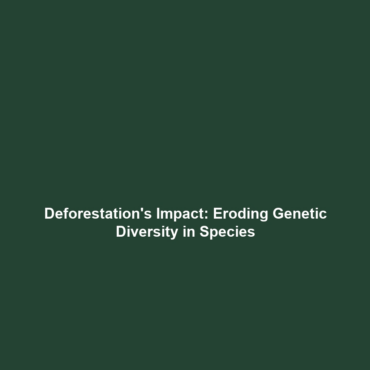How Deforestation Reduces Genetic Diversity Within Species
Introduction
Deforestation stands as a critical environmental issue that significantly impacts biodiversity across the globe. One of the most alarming consequences of deforestation is its ability to reduce genetic diversity within species, leading to increased vulnerability to diseases and environmental changes. As forests are cleared for agriculture, urbanization, and other human activities, the complex ecosystems that support diverse genetic traits are disrupted. Understanding how deforestation reduces genetic diversity is essential for developing effective conservation strategies and mitigating biodiversity loss.
Key Concepts
Genetic Diversity and Ecosystem Health
Genetic diversity refers to the variety of genes within a species, enabling populations to adapt to changing environments and resist diseases. Deforestation can fragment habitats, isolating populations and limiting gene flow. This isolation can result in inbreeding, reducing genetic variation and the overall health of the population.
Impact on Species Vulnerability
As genetic diversity diminishes, species become more susceptible to diseases and environmental stressors. For instance, a population with limited genetic variation may struggle to cope with a new pathogen or shifting climate conditions, risking extinction.
Applications and Real-World Uses
The understanding of how deforestation reduces genetic diversity is critical for various conservation efforts:
- Protecting Endangered Species: Conservation strategies aim to preserve genetic diversity by establishing protected areas and wildlife corridors.
- Restoration Ecology: Reforestation efforts can help restore genetic diversity by reintroducing native species and promoting gene flow among fragmented populations.
- Climate Change Mitigation: Maintaining genetic diversity can enhance ecosystem resilience, supporting initiatives aimed at combating climate impacts related to biodiversity loss.
Current Challenges
Studying and addressing how deforestation reduces genetic diversity presents several challenges:
- Data Limitations: A lack of comprehensive genetic data for many species makes it difficult to assess the full impact of deforestation.
- Policy and Enforcement: Inadequate policies and enforcement mechanisms hinder effective conservation measures.
- Public Awareness: Limited public understanding of the importance of genetic diversity complicates conservation efforts.
Future Research and Innovations
Innovations and research into the relationship between deforestation and genetic diversity are crucial as we look to the future. Potential areas of focus include:
- Genetic Engineering: Advanced genetic engineering techniques may offer solutions for enhancing genetic diversity in endangered species.
- Remote Sensing Technology: New technology can improve monitoring of deforestation and its impacts on biodiversity.
- Modeling Tools: Ecological modeling tools can predict how changes in land use impact genetic diversity, aiding in the formulation of targeted conservation strategies.
Conclusion
In summary, deforestation has profound implications for genetic diversity within species, ultimately increasing their vulnerability to diseases and environmental changes. Addressing this challenge is crucial in our fight against biodiversity loss. Stakeholders at all levels must engage in conservation efforts and policies that mitigate deforestation’s impact on genetic diversity. For more insights into biodiversity challenges and conservation strategies, consider exploring our related articles on biodiversity importance and deforestation solutions.

Leave a Reply